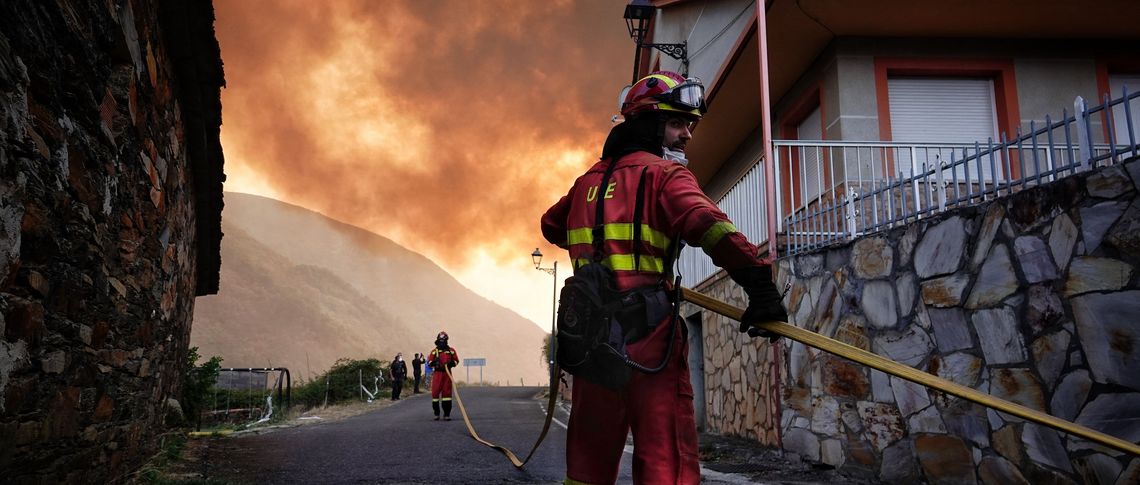Recent heatwaves across Spain this summer have been the most severe to date, leaving over 380 000 hectares of scorched and burnt land this year — nine per cent more than 2024. Between August 3-18, a 16-day heatwave peaking at 44°C caused wildfires, devastating many rural communities, with Spain evacuating over 36 000 people this summer. In addition to devastating floods around Valencia last year, a concern for the rapid succession of ‘climate emergencies’ hitting Spain is apparent.
‘The climate emergency is getting worse and more recurrent each year, and the effects of that emergency are accelerating each year’, President Pedro Sánchez said on 19 August. ‘We need to prepare and be better equipped with mechanisms and tools so that we can mitigate the effects of these climate emergencies when they happen.’
These recent emergencies demonstrate the current effects of creeping climate change in the EU, which, over a longer period, will represent a future of rural exodus and internal displacement.
Rising internal displacement
The northern and western regions of Castile and León, Extremadura and Galicia were the epicentres of the fires, where 180 people were forcibly displaced from their homes. These regions have also been suffering from a rural exodus to cities, an ageing population and a decline in farming and livestock grazing that aided in clearing forests of tinder. In 2020, 7 800 people were internally displaced within Spain, and France and Spain together accounted for 85 per cent of fire displacement in Europe since 2006. Spain had the highest number of internally displaced people in Europe due to floods, wildfires and storms, with nearly 153 000 displaced between 2008 and 2023.
Disasters are easier for measuring the number of displaced and the more dramatic effects of climate change because we can see them with our own eyes — for example, a massive flood in the street. It’s the slow socioeconomic and demographic changes that affect our food and water supply, for example, that are harder to measure and will cause massive internal displacement in the coming years.
What happens in Spain today is a preview of what other EU states are already beginning to face.
Spain is becoming drier. The process of desertification – where arable land becomes arid and inhospitable – is already underway in much of the country. Catalonia declared a brief drought emergency after over three years of insufficient rainfall, and the southern province of Andalucia, once the top rice producer of Spain, has seen its flooded rice fields produce less and less yield each year. Desertification could affect up to 80 per cent of Spain by the end of the century, and the number of heat-related deaths could rise by 12 000 by 2030, a report by the University of Macerata suggests.
A degradation in agriculture and arable land in already depopulating regions has caused a ‘rural exodus’ to cities, which means not only implications for the economy, but also further environmental and social ones too. A depopulating region facing drought leads to a lack of conservation and agricultural caregiving, increasing soil erosion and forest fires, putting agri-food activities, which are essential for cities, at risk. In a cultural-identity sense, it also means a slow bleed of those with knowledge and practices linked to the rural landscapes, and a loss of tradition.
This rural exodus is one of the more difficult quantifiers of climate change because people do not always leave their homes because of a disaster, but because of impoverishment linked to environmental degradation due to climate change. Population movement is something that cannot be avoided. It can, however, be managed.
Yet Spain is not an isolated case. In recent summers, Italy, France, Portugal and the Balkans have also endured record-breaking heatwaves and devastating fires. What happens in Spain today is a preview of what other EU states are already beginning to face.
The need for a broader European framework
Spain is already beginning to reckon with this challenge. In fire-prone regions such as Castile and León and Extremadura, municipalities have written population movement into their development charters — a striking acknowledgement that internal displacement is no longer hypothetical but a lived reality. But the broader European framework for responding to climate-induced displacement remains fragmented.
The EU has invested heavily in research and preparedness. The Joint Research Centre runs projects to estimate displacement and migration linked to climate impacts, and the Horizon 2020 ‘HABITABLE’ programme is explicitly focused on the habitability of vulnerable regions under slow-onset events like desertification. Internationally, the EU participates in the UN Task Force on Displacement, which has mapped human mobility and climate change across national and international policies, and contributes to the High-Level Panel on Internal Displacement. At a humanitarian level, EU-funded programmes have integrated a ‘resilience marker’ requiring partners to address risks such as displacement in health, food security, shelter and protection interventions. Early-warning systems and risk analysis tools are increasingly promoted to anticipate crises before they escalate.
Strengthening EU-wide resilience means going beyond research and ad hoc humanitarian response.
Yet significant weaknesses remain. Disaster preparedness is still primarily reactive, with financing and leadership for protection clusters in post-disaster situations unpredictable and dependent on UN agency negotiations. The EU Climate Adaptation Strategy, launched in 2021, mentions resilience but does not explicitly address climate-induced displacement, leaving a major policy gap. Rights-based approaches to protect vulnerable groups, including women, youth, indigenous communities and the rural poor, are inconsistently applied. Unlike Africa’s Kampala Convention or IGAD’s Free Movement Protocol, Europe lacks a legal framework that recognises displacement as a direct consequence of climate change or provides safeguards for those affected. Current EU free movement law only allows three months’ residence without proof of resources, which is ill-suited for people fleeing climate emergencies.
In her annual State of the Union speech to the European Parliament, European Commission President Ursula von der Leyen proposed a regional firefighting hub based in Cyprus, saying ‘we have to radically step up our efforts into climate resilience and adaptation, and nature-based solutions.’ This is a measure that merely dips a toe into the pool of challenges ahead for Europe and its neighbours.
The lesson from Spain is clear: displacement within Europe is already happening. Strengthening EU-wide resilience means going beyond research and ad hoc humanitarian response. Explicit recognition of climate displacement in EU law, stable leadership on protection and locally grounded adaptation strategies, such as those being pioneered in rural Spain, are essential if the Union is to manage the social fractures that climate change is accelerating.






